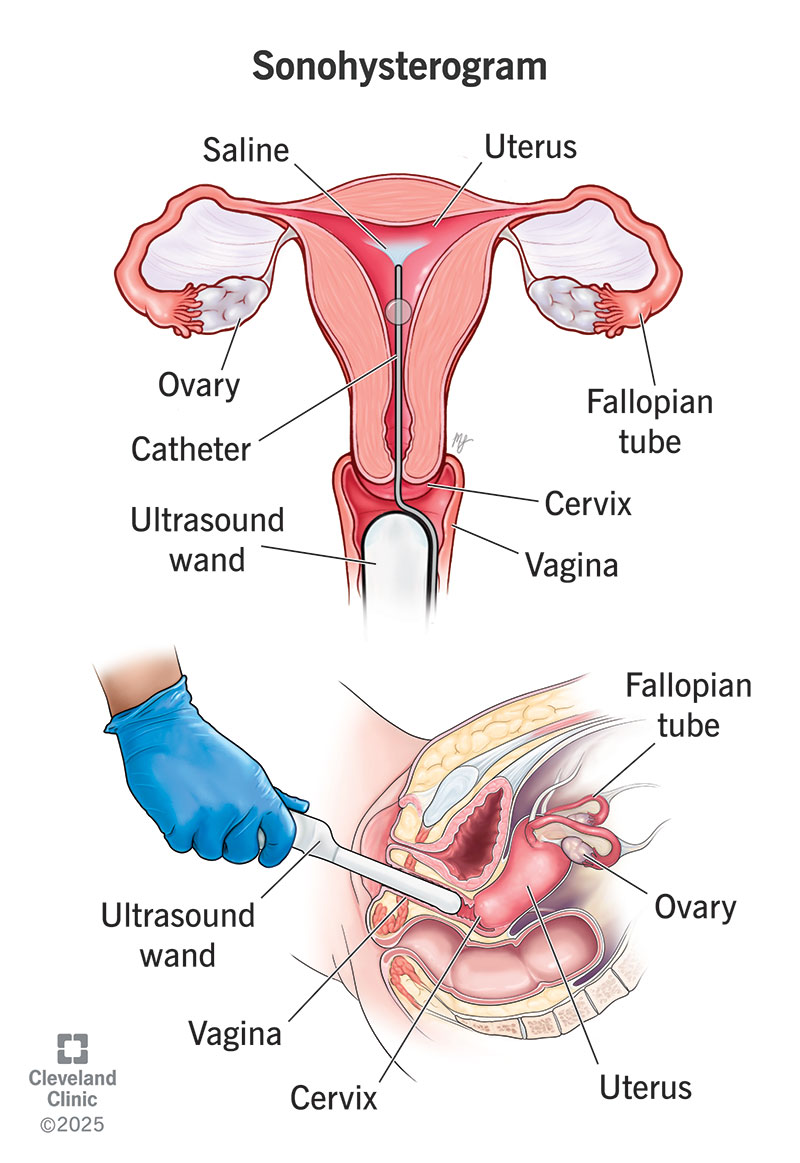A sonohysterogram is an imaging procedure that allows your healthcare provider to see inside your uterus. It’s a safe procedure that can help shed light on what’s causing issues like pelvic pain, irregular bleeding and infertility.
Advertisement
Cleveland Clinic is a non-profit academic medical center. Advertising on our site helps support our mission. We do not endorse non-Cleveland Clinic products or services. Policy

A sonohysterogram (SHG) is a type of transvaginal ultrasound exam that lets your healthcare provider see inside your uterus. It involves the insertion of saline (sterile fluid) through your cervix to better view your uterine cavity. It’s also called saline infusion sonography (SIS).
Advertisement
Cleveland Clinic is a non-profit academic medical center. Advertising on our site helps support our mission. We do not endorse non-Cleveland Clinic products or services. Policy
A sonohysterogram can help diagnose issues in your uterus and uterine lining (endometrium) that may be causing symptoms.
You may need a sonohysterogram if you have:
You’ll need to schedule the test based on the timing of your menstrual cycle.
The best time to get a sonohysterogram is after your period has ended but before you ovulate (usually days six to 11 of your cycle). This is when the lining of your uterus is thinnest. Your healthcare provider will be able to see it most clearly. If you’re menopausal, taking a continuous birth control pill or have a hormonal IUD, you can get the procedure at any time.
Your provider may prescribe medications to temporarily manage heavy bleeding if needed. It’s more difficult for your provider to get a clear view of your uterine lining if you’re bleeding. If you’re menopausal or have a cervix with a narrow opening, your provider may give you a pill to take the night before to soften your cervix.
Follow any instructions your provider shares to prepare for the sonohysterogram.
Advertisement
On the day of your sonohysterogram, plan to:
Right before the procedure:
In general, you can expect the following during a sonohysterogram:
The sonohysterogram visit should take about 30 to 45 minutes. The part involving the fluid in your uterus only lasts five to 10 minutes.
Mild pain or discomfort is common with a sonohysterogram. You may feel cramping when your healthcare provider inserts the catheter into your cervix and pressure when they fill your uterus with saline.
The cramping should improve quickly after the procedure and after the fluid drains out. Taking over-the-counter NSAIDs and using a heating pad may help.
It’s important to remember that everyone experiences pain differently. Some may describe this procedure as causing mild discomfort. Others may have moderate pain.
Tell your healthcare provider if you feel intense pain at any point during the procedure. You don’t have to push through the pain.
A sonohysterogram is an overall safe test. In rare cases, it can lead to a pelvic infection. Let your healthcare provider know right away if you have these signs of an infection:
You should be able to go home and return to your normal routine after the sonohysterogram. You may experience the following:
Advertisement
A sonohysterogram can reveal structures inside your uterus that may be causing issues. It can show:
Your healthcare provider will explain the results of the test. Don’t hesitate to ask questions.
Depending on the results, your provider may:
The main difference is that a sonohysterogram involves the insertion of saline into your uterus. A standard ultrasound of your uterus — either a pelvic ultrasound or transvaginal ultrasound — doesn’t involve saline.
Taking images of your uterus and other structures before and after the saline insertion allows your healthcare provider to better visualize your uterine cavity and lining.
Hysterosalpingography (HSG) uses radiation and contrast dye — instead of sound waves and saline — to record structures in your uterus. Healthcare providers typically use HSG to look for structural issues causing infertility. They tend to use sonohysterography to help diagnose a range of conditions.
Advertisement
An HSG can show if there’s a blockage in your fallopian tubes that may be causing fertility issues. These blockages don’t always show up on a sonohysterogram.
It’s understandable if you’re nervous about getting a sonohysterogram (SHG). It’s a procedure involving a sensitive, personal and private area. But a sonohysterogram can help your healthcare provider diagnose a range of conditions that may be causing disruptive symptoms, like irregular bleeding and pelvic pain.
If you’re feeling uneasy about the procedure, talk to your provider before they get started. They can help you through it, let you know what to expect and make sure the experience is as comfortable as possible.
Advertisement
From routine pelvic exams to high-risk pregnancies, Cleveland Clinic’s Ob/Gyns are here for you at any point in life.

Last reviewed on 05/23/2025.
Learn more about the Health Library and our editorial process.